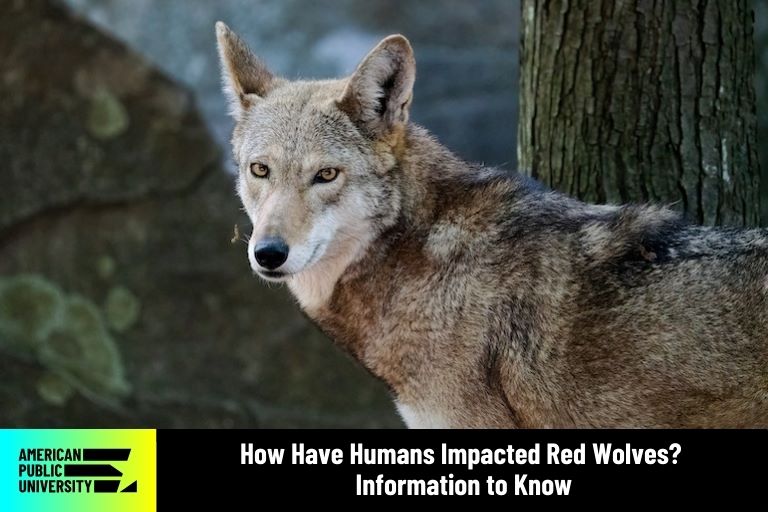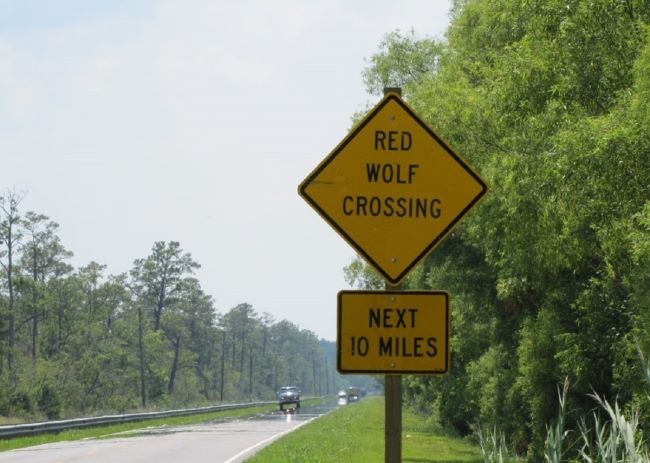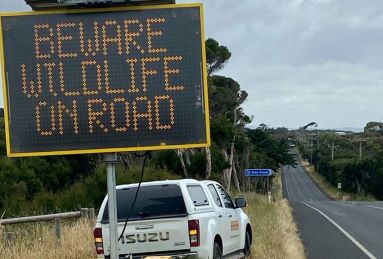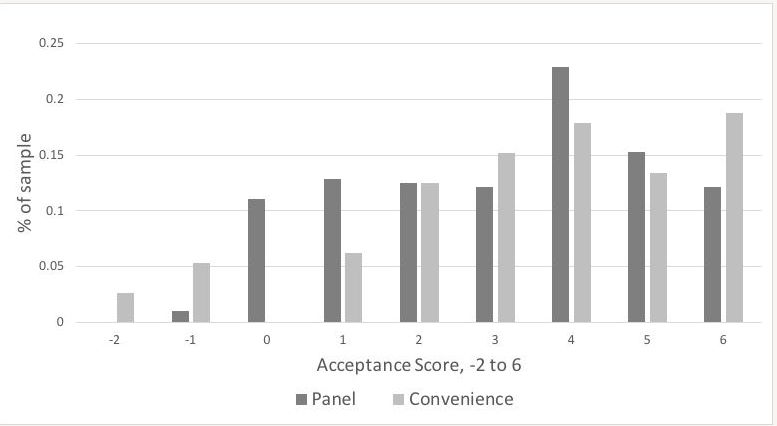By Dr. Suzanne Agan | 05/22/2024

How have humans impacted Red Wolves? The answer to that question involves a much deeper response than just the last few years involving the loss of Red Wolves.
Red Wolves Hold Spiritual Significance for Native Americans
Known as the Red Grandfather or Gigage-Unidoda to the Cherokee people, the Red Wolf is part of a cultural heritage to our Native Americans. Out of the seven Cherokee clans, the Wolf Clan has historically been the largest clan and wolves are viewed as protectors.
Dr. Candessa Tehee, a Cherokee National Treasure, described the current views of Red Wolves as a mismatch in Western and indigenous world views. She notes, “We don’t place ourselves higher than the things around us.”
Instead, Red Wolves hold a spiritual significance. As protectors of the national balance of the world around us, they are greatly respected and seen as teachers.
Native American values involve harmony, balance, and sustainability, and these are values applied to the world around them, including Red Wolves. You can’t have harmony and balance if your goal is to dominate, which was the major view of Europeans as they moved into and across the continent. Europeans and wolves feared and avoided each other as there was plenty of space between them.
Wolves Were Feared as Predators When Europeans Settled into the US
The fear of predators eventually shifted into fear of losing livestock when the Europeans began to bring in horses, cattle, sheep, and pigs across the Atlantic. What came next was a complete extermination mindset. Europeans sought to tame the wild so they could be the top predator, making their way with no regard to the world around them except to bend its will to them.
According to PBS, the U.S. Fish and Wildlife Service said, “To protect livestock, ranchers and government agencies began an eradication campaign. Bounty programs initiated in the 19th century continued as late as 1965, offering $20 to $50 per wolf.
“Wolves were trapped, shot, dug from their dens, and hunted with dogs. Poisoned animal carcasses were left out for wolves, a practice that also killed eagles, ravens, foxes, bears, and other animals that fed on the tainted carrion.”
Wealthy landowners demanded the government secure their lands for safe livestock pasture. While that demand occurred in the 19th century, that statement still rings true today. How far have we really come?
Why Northeastern North Carolina Was Chosen as the First Wild Red Wolf Reintroduction Site
One of the reasons northeastern North Carolina was chosen for the first wild Red Wolf reintroduction site was its lack of livestock. Learning from the past, the goal of the United States Fish and Wildlife Service was to decrease human/carnivore conflict while restoring a vital keystone predator to the ecosystem.
Red Wolves were once abundant throughout the eastern U.S. from the Atlantic Coast and as far west as Texas. Their habitat also ranged from the Gulf of Mexico north to the Ohio River Valley and central New York.
However, eradication and bounty programs were very successful and by 1944, the last Red Wolves were extirpated east of the Mississippi.
In 1967, Red Wolves were considered endangered and would be one of the first species listed in the Endangered Species Act of 1972. Finally, the remaining Red Wolves were captured, and they were declared extinct in the wild until the captive breeding program enabled future reintroductions.
After reading about 200 years of killing and hatred for this endangered species, I can’t help but note a shift here. While we often focus on the negative aspects of human-wolf interactions, it’s at this point we see another side to our own nature, a side that is often overlooked because it’s quiet.
While leading the charge to save the Red Wolf population, the U.S. Fish and Wildlife Service was joined by zoos, aquariums, researchers, non-profits and similar organizations. There is a major voice in this land of respect and care for Red Wolves. But will it be enough?
Many Wolf Deaths Occur Due to Poaching and Vehicle Strikes
Looking back over the first 30 years of recovery in northeastern North Carolina, the United States Fish and Wildlife Service has data on 508 Red Wolves. Out of that number, 149 out of 312 endangered Red Wolves whose cause of death is known were killed by poachers. That’s almost half the known population of Red Wolves.
However, that’s not the only number that concerns me. The deaths of another 196 Red Wolves were determined “fate unknown” (81 of those wolves were found but their cause of death was unknown; 115 went missing and were never found). Many of these wolves were most likely poached as well.
In our study, it was male hunters with the highest inclination to poach a Red Wolf. This fact is important because those hunters have both the means (gun) and the opportunity (in more remote areas where Red Wolves reside).
But killing a Red Wolf is not always an intentional act. Some hunters have reported mistaking Red Wolves for coyotes.
Killing One Wolf Affects Its Pack Members and the Larger Red Wolf Population
So what did 2023 mean for this population? A breeding male released in May was found dead in July, along with one of his pups. The remaining pups were likely abandoned, and the female was relocated back to the captive breeding program after depredating chickens.
Another female, also released in May, was found dead. A male released in May was found dead of a confirmed gunshot wound in August.
All of these deaths are under investigation. That’s four deaths, all under suspicious circumstances. But those deaths affected more of the Red Wolf population, including the abandoned pups and relocated female.
These facts are clear examples of how the deaths of Red Wolves affect the larger population. Currently, there are only two family groups.
Poaching is not the only way that humans impact Red Wolves. You will also notice a considerable number of wolves are lost to vehicle strikes. In fact, 66 out of 312 wolves were lost to vehicles during the first 30 years of recovery.
If you have the opportunity to drive down the road through Alligator River National Wildlife Refuge in eastern North Carolina, you may see why. It’s a long, straight road with wooded and wetland areas on either side. The road is not only a great highway for vehicles but an easy passage for wolves and other wildlife.
In 2023 alone, the road death toll was a major hit to the current wild population of Red Wolves. A seven-year-old female was found on the side of the road in July. The breeding male from the Milltail family group was struck and killed in September. A 2023 spring pup born in the wild was killed by a vehicle on December 22, 2023.


Red Wolf and wildlife warning signs. Images courtesy of the U.S. Fish and Wildlife Service.
Humans impact Red Wolves in so many ways, and poaching and vehicle strikes are only two of the most obvious. We affect Red Wolves through the direct actions of killing them or protecting them. Also, we impact these wolves through our voices, financial contributions, tourism, everyday actions, and even indirectly through habitat loss.
When I sat down to talk with Red Wolf country landowners during my research to explore in greater detail why the Red Wolf is endangered, I didn't find what I thought I would. The landowners I spoke with had lived in the Red Wolf recovery area since it began in 1987 and were on private lands where wild populations of wolves were known to be located.
The important thing to me was to talk to those landowners who truly had “skin in the game,” who were living with wild Red Wolves. I didn’t ask any leading questions. Rather, I just let them tell their stories as they experienced it.
Most of the people I encountered really didn't have anything against the Red Wolf. Some were frustrated at how the USFWS handled the situation in the beginning, and others just didn't want the government involved in their private lands.
I found that many people were uninformed about the current policy surrounding the Red Wolf Recovery Program. Ultimately, some people just didn't care and wanted all predators to be gone from the landscape.
After speaking with those landowners, we surveyed the larger Red Wolf recovery area residents to find out how they felt about having wild Red Wolves in their area of eastern North Carolina. We intentionally surveyed those people who knew about Red Wolves (convenience) and those who didn't (panel) to get a variety of responses.
What we found was highly positive. A significant number of both of these groups had a high level of acceptance for the recovery program where they live.

Acceptance scores for the Red Wolf Recovery Program. Image courtesy of author.
Why Are Humans the Largest Threat to the Survival of Red Wolves?
Why is it that humans are the largest threat to the survival of the only wild population of endangered Red Wolves? That's a complicated question, but hopefully we have at least a few insights.
We discovered there is a distinct difference between the public attitude toward Red Wolves and the public attitude toward the United State Fish and Wildlife Service recovery program. This distinction leaves an opening for education and cooperation, which has not been sufficient in the past.
It should be understood that it only takes one person to poach or kill a Red Wolf and have far-reaching consequences. We have already seen how the loss of one wolf can mean the loss of an entire family group. With only two family groups of Red Wolves still in existence, that could mean the loss of the remaining population.
But if one person can make a negative difference, another person can make a positive difference for good. In speaking with landowners, a common thread was woven throughout most of our conversations.
There was a local Red Wolf biologist, Chris Lucash, who earned the utmost respect of local landowners. As a result, they wouldn't kill a Red Wolf out of respect for him, if for no other reason.
Lucash made an impact on the endangered Red Wolf population that did not go unnoticed. After he passed away from amyotrophic lateral sclerosis, (ALS), an award-winning film called “Staring Down Fate” was made about his dedication to the Red Wolf species. We certainly could not talk about human impacts to this species without bringing him into the picture.
A New Revision to the Red Wolf Recovery Plan
So what do we do now? In September 2023, the Red Wolf Recovery Team released the new revision of the Red Wolf Recovery Plan.
The vision of this plan is "In the future, wild and free Red Wolves will coexist with humans in multiple viable populations across the historic range, where ongoing threats are effectively ameliorated through conservation activities, the public’s trust and engagement, and aligned policies among all involved with Red Wolf recovery. The recovery of the Red Wolf will provide a strong sense of community ownership, cultural importance, and pride, in line with the values of the communities in which they occur."
This plan was crafted by 52 members from:
- Different universities
- State, local, and government agencies
- Non-profits
- Tribes
- Zoos
- Landowners
- Independent consultants
All of these people and organizations are working to have a positive impact on the future of Red Wolves. After spending time in the company of people who have personally poached these Red Wolves, the landowners who live with these animals, and the people acting to save them, I am hopeful.
That hope hinges on the success of the cooperation between citizens and government agencies to foster a coexistence between humans and this endangered species. It also depends on hunters being able to distinguish Red Wolves wearing new, bright orange collars or even better, opting not to shoot any animal resembling a Red Wolf.
The hope of coexistence also hinges on hunters holding each other accountable. The survival of this keystone species means a healthier ecosystem for all species, including white-tailed deer.
Finally, all of us need to make good choices when we drive, pay attention to those signs, and be good citizens who value good stewardship of the world around us.
The topic of human impacts to this endangered species has run the range of emotions from depression to excitement, but it's where we must start. In the past, the few voices opposing Red Wolf recovery have been loud and successful, because the proponents for Red Wolf recovery have been quiet or even silent.
How have humans impacted Red Wolves? The better question is, “How will humans impact Red Wolves in the future?”
Dr. Suzanne Agan is an instructor in the School of Science, Technology, Engineering and Math. She holds a B.S. in Biology from the University of North Carolina at Greensboro, a M.S. in Wildlife Science from Texas A&M University, a M.S. in Interdisciplinary Environmental Studies from Antioch University, and a Ph.D. in Environmental Science from Antioch University New England.
Suzanne has been an educator in wildlife, conservation, and environmental sciences for almost 20 years after working in the field as a wildlife biologist. Her interdisciplinary Ph.D. research focused on spatial, ecological, and human dimension aspects of red wolf survival. She currently serves on the USFWS Red Wolf Recovery Team and is co-chair of the APU/AMU Student Chapter of the Wildlife Society. In addition, Suzanne is a faculty advisor for the University’s chapters of Women in STEM (wSTEM) and the Association of Women in Science (AWIS).

